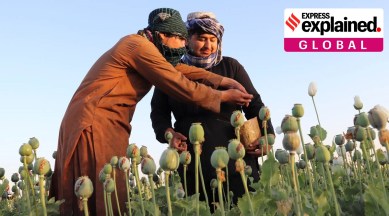Poppy love in Afghanistan
A new UN report says the land under poppy cultivation in Afghanistan in 2021 increased by 32% over the previous year. With the Taliban strapped for cash, opiates are now a crucial pillar of the country’s economy

It’s been described as the best cash transfer system. Grow poppy, get money. Driven by the demand for heroin and other opioids, mostly in the West, Afghanistan’s poppy farmers have figured out that in a broken country where there are no jobs, and the de facto government has no money, poppy guarantees survival.
A new report by the United Nations Office on Drugs and Crime (UNODC) released earlier this week says the land under poppy cultivation in Afghanistan in 2021 (October and November are the sowing season) increased by 32 per cent over the previous year. If the harvest (in spring) had not been affected by a drought that hit many parts of Afghanistan, there would have been a bumper crop.
A ban on cultivation imposed by the Taliban in April exempted the standing crop and harvest, and sent the price of opium shooting.
A new sowing season has begun, and to what extent the ban is being enforced is not yet clear. Last year, poppy was sown on 233,000 hectares, and in some places, farmers even replaced traditional crops with poppy.
The UNODC report says the 2021 harvest of 6,200 tonnes, 10 per cent less than in 2021, could be converted into 350-380 tonnes of export-quality heroin. Eighty per cent of the world’s opiates come from Afghanistan.
The income of farmers from opium sales more than tripled from $425 million in 2021 to $1.4 billion in 2022, according to the report — 29 per cent of the Afghan agricultural sector’s total value in 2022, higher by 20 percentage points over the previous year.
Taliban, opium, the economy
In spite of their Islamic instincts against narcotics, the Taliban had realised the value of poppy by the time they first stormed to power in 1996 and, by extension, the political cost of banning it. In an article written last year for Small Wars Journal, Vanda Felbab-Brown noted that at a time they faced near total international ostracism, the Taliban found they could fall back on money from poppy cultivation to run the show. (Pipe Dreams: The Taliban and Drugs from the 1990s into its New Regime)
“The 10% zakat on opium, formerly paid to the village mullahs, was now directed to the Taliban’s treasury, earning an estimated $9 million in 1996-7, from the south’s regular output of 1,500 tonnes of opium. A 10% zakat was also levied on the traffickers. As the 1990s progressed, these taxes were increased to 20%, bringing in $45 million to $200 million a year.
“By 1999, the Taliban also taxed heroin labs. [They]…sought to expand and regulate the narcotics economy by providing official government licenses for opium cultivation, by setting up model farms teaching the farmers how to grow poppy more efficiently, and by distributing fertilizers…,” Felbab-Brown wrote.
As a labour intensive crop, poppy was a great source of employment in rural Afghanistan, and led to other trickle-down economic activities. Distributing the work of revenue collection was also a way to keep the factions within from rebelling.
The opium trade was low priority for the US military. In its fight against the Taliban, it enlisted the support of warlords who were in the trade themselves. The addresses in the Sherpur area of Kabul, famous for its “poppy palaces” developed in the early years of this century, are like a directory of the who’s who of the Afghan conflict. It was in Sherpur that al-Qaeda chief Ayman al-Zawahiri was killed in August — in a house that belonged to the Afghan interior minister Sirajuddin Haqqani.
The narcotics trade was not part of the discussions during the talks with the Trump administration, and the 2020 Doha Accords signed by the US and the Taliban made no mention of the illegal drugs trade.
By the time the Biden administration completed the US pullout, the Taliban’s coffers had swelled with that year’s opium money. A report in 2020 said the Taliban’s profits from the illicit drug trade, illegal mining, and exports had earned it as much as $1.6 billion, of which $416 million was from the drug trade alone.
History on loop
With the Taliban back in power, Afghanistan’s situation is not very different from the 1990s. Still international outcasts and with no access to global funding, they are scrambling to raise money by levying taxes, as humanitarian aid keeps Afghanistan going.
Against this background, opiates are now “a crucial pillar of Afghanistan’s economy and permeate the rural society to the extent that many communities…have become dependent on the income from opium to sustain their livelihoods,” the UN report says. The opiate economy, including local consumption and export, was valued at 9-14% per cent of the country’s GDP. With a shrinking GDP in 2022, it may now represent an even bigger share of the economy, the report says.
The ban on cultivation imposed in April is a throwback to a similar ban the Taliban imposed in 1999. The spike in opium prices this year is a consequence of the ban. High prices may act as an incentive for more poppy cultivation. Not implementing the ban would help the Taliban both economically and politically.
Regional concern
Russia and Afghanistan’s Central Asian neighbours view drugs as a top concern, more perhaps than the threat of religious extremism, radicalisation, and terrorism. India has voiced concerns about it from time to time. At the Shanghai Co-operation Organisation security meetings, the threat of terrorism and drug trafficking from Afghanistan are discussed as inter-related threats to regional and global security.